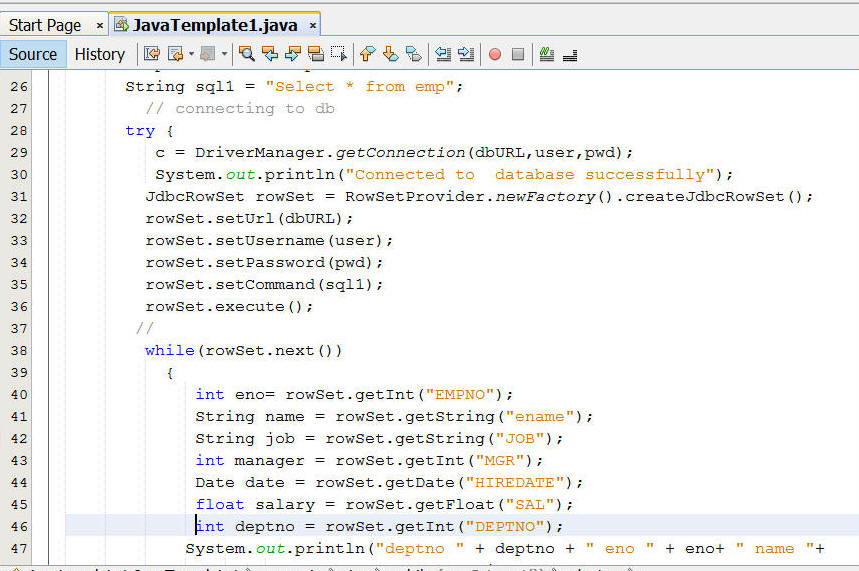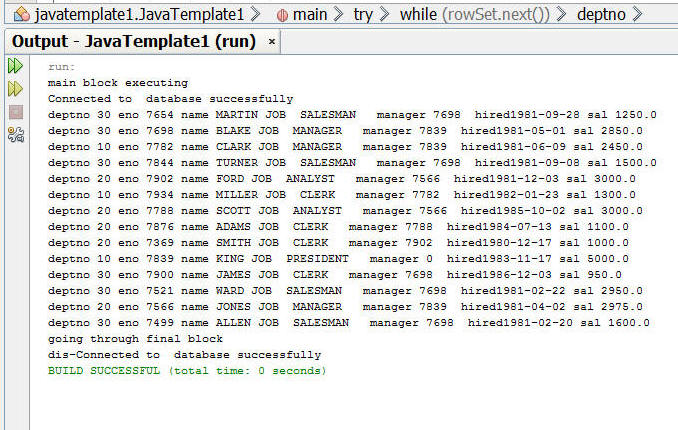- A ResultSet requires a stable connection to a database, and unlike Rowset it cant be serialized and you can't pass the Resultset object from one class to other class across the network.
- RowSet is a serializable version of a JDBC ResultSet, essentially a Java Bean, and it also the RowSet extends the ResultSet interface suppoerting all the methods of ResultSet.
- The RowSet can be connected or disconnected, serialized, and also it can be sent from one class
to another across the network.
- Query results are scrollable and updatable without relying on the underlying JDBC driver
- Read and Write data results to or from XML documents
- Has following five interfaces : JdbcRowSet, CachedRowSet, WebRowSet, JoinRowSet, and FilteredRowSet
- Connected VS Disconnected RowSet
- Connected : JdbcRowset, maintains it's connection to DB through out its life cycle.
- Disconnected : WebRowSet and ChachedRowSet, doest need active connection to DB, must reestablish connection to commit any changes.
- CahedRowSet : The CachedRowSet object represents disconnected
RowSet holds data row data and metadata in a buffer so that when the
connection to the database is restored, the altered data in the
RowSet are submitted back to the database.
- A CachedRowSet object includes all the functionalities of a
JdbcRowSet object plus it can also do the following:
Obtain a connection to a data source and execute a query.
Read the data from the resulting ResultSet object and populate itself with that data
It allows you to manipulate data and make changes while it is disconnected from the db
Must Reconnect to the data source to write or alter the data to table
Check for conflicts with the data source and resolve those conflicts
- A CachedRowSet object includes all the functionalities of a
JdbcRowSet object plus it can also do the following:
- WebRowset :with a WebRowSetXmlWriter writes rowset to an XML
document and using a WebRowSetXmlReader, it reads an XML document
into the rowset.
- A WebRowSet object has all the functionalites of a CachedRowSet
object, in additions it can it allows the following
operations:
Write itself as an XML document
Read an XML document through a WebRowSet object
- A WebRowSet object has all the functionalites of a CachedRowSet
object, in additions it can it allows the following
operations:
- FilteredRowSet object simulates a SQL WHERE clause
- A FilteredRowSet object includes all the options of WebRowSet
object (and therefore also a CachedRowSet object) plus it can also
do the following:
Apply filtering criteria so that only selected data is visible. This is equivalent to executing a query on a RowSet object without having to use a query language or connect to a data source.
- A FilteredRowSet object includes all the options of WebRowSet
object (and therefore also a CachedRowSet object) plus it can also
do the following:
- JoinRowSet represents SQL join among the disconnected RowSets.
- A JoinRowSet object has all the capabilities of a WebRowSet
object (and therefore
also a CachedRowSet object) plus it can also do the following:
Form the equivalent of an SQL JOIN without having to connect to a data
source.
- A JoinRowSet object has all the capabilities of a WebRowSet
object (and therefore
- default constructor:
JdbcRowSet rowset = new JdbcRowSetImpl(); - with RowSetProvider Interface:
- rowSet = RowSetProvider.newFactory().createJdbcRowSet();
- SQL query steps:
rowSet.setCommand(sql1);
rowSet.execute();

package
javatemplate1;
import java.sql.Connection;
import java.sql.Date;
import java.sql.DriverManager;
import java.sql.PreparedStatement;
import java.sql.ResultSet;
import java.sql.SQLException;
import java.sql.Statement;
import javax.sql.RowSetEvent;
import javax.sql.RowSetListener;
import javax.sql.rowset.JdbcRowSet;
import javax.sql.rowset.RowSetProvider;
/**
*
* @author Manas14
*/
public class JavaTemplate1 {
public static void main(String[] args) {
// TODO code application logic here
System.out.println("main block executing ");
Connection c = null;
String dbURL = "jdbc:postgresql://localhost:5432/pgsdemo1";
String user = "postgres"; String pwd = "postgre_manas9";
PreparedStatement ps= null;
String sql1 = "Select * from emp";
// connecting to db
try {
c = DriverManager.getConnection(dbURL,user,pwd);
System.out.println("Connected to database successfully");
JdbcRowSet rowSet = RowSetProvider.newFactory().createJdbcRowSet();
rowSet.setUrl(dbURL);
rowSet.setUsername(user);
rowSet.setPassword(pwd);
rowSet.setCommand(sql1);
rowSet.execute();
//
while(rowSet.next())
{
int eno= rowSet.getInt("EMPNO");
String name = rowSet.getString("ename");
String job = rowSet.getString("JOB");
int manager = rowSet.getInt("MGR");
Date date = rowSet.getDate("HIREDATE");
float salary = rowSet.getFloat("SAL");
// double commision = rs.getInt("COMM");
int deptno = rowSet.getInt("DEPTNO");
System.out.println("deptno " + deptno + " eno " + eno+ " name "+
name + " JOB " + job +" manager " + manager +
" hired" + date + " sal " + salary );
}
//
} catch (SQLException ex) { ex.getErrorCode();
String message = ex.getMessage();
System.out.println(message);
} finally {
System.out.println("going through final block");
try {
if (ps== null || ps.isClosed()) {
} else {
ps.close();
}
if (c != null && !c.isClosed()) {
c.close(); }
} catch (SQLException ex) { ex.getErrorCode();
ex.getMessage();
}
}
System.out.println("dis-Connected to database successfully");
// st.close(); con.commit();con.close();
}
}

I relied on the content of this document
" JDBC TM RowSet Implementations Tutorial
Maydene Fisher with contributions from Jonathan Bruce, Amit Handa &
Shreyas Kaushik "
Sun Microsystems Inc.
4150 Network Circle
Santa Clara, CA 95054
USA
Revision 1.0